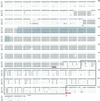Alu-mediated inactivation of the human CMP- N-acetylneuraminic acid hydroxylase gene
- PMID: 11562455
- PMCID: PMC58741
- DOI: 10.1073/pnas.191268198
Alu-mediated inactivation of the human CMP- N-acetylneuraminic acid hydroxylase gene
Abstract
Inactivation of the CMP-N-acetylneuraminic acid hydroxylase gene has provided an example of human-specific genomic mutation that results in a widespread biochemical difference between human and nonhuman primates. We have found that, although a region containing a 92-bp exon and an AluSq element in the hydroxylase gene is intact in all nonhuman primates examined, the same region in the human genome is replaced by an AluY element that was disseminated at least one million years ago. We propose a mechanistic model for this Alu-mediated replacement event, which deleted the 92-bp exon and thus inactivated the human hydroxylase gene. It is suggested that Alu elements have played potentially important roles in genotypic and phenotypic evolution in the hominid lineage.
Figures




References
-
- Klein R G. The Human Career: Human Biological and Cultural Origins. Chicago: Univ. of Chicago Press; 1999.
-
- Satta Y, Klein J, Takahata N. Mol Phylogenet Evol. 2000;14:259–275. - PubMed
-
- Ruvolo M. Mol Biol Evol. 1997;14:248–265. - PubMed
-
- Gagneux P, Varki A. Mol Phylogenet Evol. 2001;18:2–13. - PubMed
-
- Gibbons A. Science. 1998;281:1432–1434. - PubMed
Publication types
MeSH terms
Substances
Associated data
- Actions
- Actions
- Actions
- Actions
Grants and funding
LinkOut - more resources
Full Text Sources
Other Literature Sources
Molecular Biology Databases

